Rotherham Corporation Tramways
Summary
Conductors and motormen intially wore double-breasted jackets bearing five pairs of buttons, and lapels, the top pair of buttons being mounted between the lapels and the collars. The buttons bore a municipal device and the full system title (see link) and were almost certainly brass. Although the collar insignia cannot be made out on the earliest photographs, by the mid-Edwardian era the jackets certainly bore a brass employee number on the bearer's left-hand collar, and individual brass system initials — 'R C T' — on the right. The first photograph below suggests that uniform caps may have been late arriving, as both men are clearly wearing flat caps, but with uniform jackets and trousers. The official peaked caps, when delivered, were of the tensioned-crown (top) variety; they bore brass script-lettering grade badges — either 'Conductor' or 'Motorman' — above which a brass municipal-device badge was probably worn. Although the latter cannot be made out with certainty on the earliest photographs, later images clearly show it to have comprised two shields (one bearing three cannons and the other three stags) either side of a caduceus (the staff of Hermes). In later years, tramcar crews were provided with black rain covers for their caps, which they were required to wear during the summer months.
In the mid-to-late Edwardian era, the jackets were changed to a lancer style with five pairs of buttons narrowing from top to bottom, stand-up collars and epaulettes. It is unclear what insignia these jackets bore, though in all likelihood, it was the same as those used on the earlier jackets. By the 1920s, and possibly from much earlier, a return had been made to the original style of jackets, i.e., double-breasted with lapels. Whilst this style of jacket remained in use right through to the end of tramway operation in 1949, the button and badge material was at some point changed to nickel, probably shortly after the end of the Great War, numerous examples of titled nickel tramway buttons having survived.
The script-lettering grade badges were dispensed with in the early 1920s (certainly by 1926), leaving the municipal-device badge as the sole cap adornment.
Given that the name of the undertaking was changed to Rotherham Corporation Transport around 1929, at some point subsequent to this, new issues of uniforms would almost certainly have borne titled Rotherham Corporation Transport buttons; these were initially nickel, but were almost certainly changed to chrome prior to the demise of the trams.
Motormen and conductors were also provided with double-breasted greatcoats with high fold-over collars; it is unclear whether the latter bore any insignia.
Photographs of senior staff are extremely rare; all that can be stated with confidence is that during the 1920s they appear to have worn similar uniforms to tramcar crews, but with different collar insignia, more than likely the grade on one side and system initials on the other, and probably embroidered.
In common with the vast majority of UK tramway systems, the RCT employed the services of female staff during the Great War to replace tramwaymen lost to the armed services. The first conductress started on 30th October 1915, and eventually over sixty were employed; female employees were, however, never trained to drive the trams due to the steep gradients on the system. The ladies were provided with tailored, double-breasted jackets bearing five pairs of buttons (narrowing slightly from top to bottom), epaulettes and high fold-over collars, as well as long matching skirts. It is unclear what insignia, if any, the jackets carried. Two types of hat are believed to have been worn, namely, dark-coloured bonnets (bearing a hat band) and baggy peaked motor caps, probably for summer and winter wear respectively. Both types appear to have borne the standard municipal-device badge, but without a grade badge.
Details of the uniforms worn by female staff during the Second World War are sketchy, though the tailored jackets were certainly single-breasted with lapels. The caps were akin to military field caps, with cloth peaks (probably); they bore the standard municipal-device badge.
For a history of Rotherham's tramway system, see: 'Rotherham and District Transport', 'Vol 1 to 1914', 'Vol 2 to 1939', 'Vol 3 to 1974' by C C Hall; Rotherwood Press (1996, 1998 and 1999, respectively).
Images
Motormen and conductors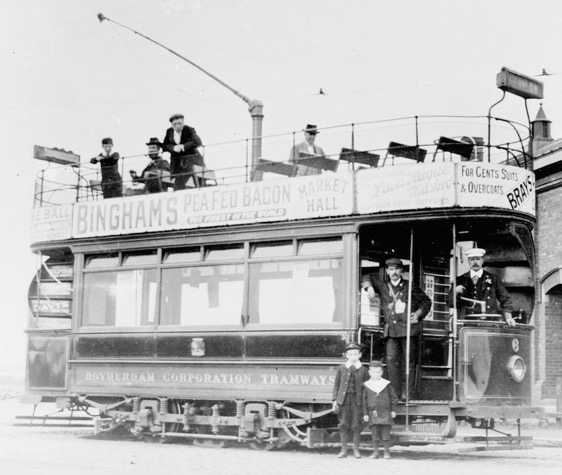
The crew of Tramcar No 6, which was delivered in 1902, pose for the camera at the Rawmarsh Road terminus — photo undated, but probably taken around the time of opening, i.e., 1903. Photo courtesy of the National Tramway Museum.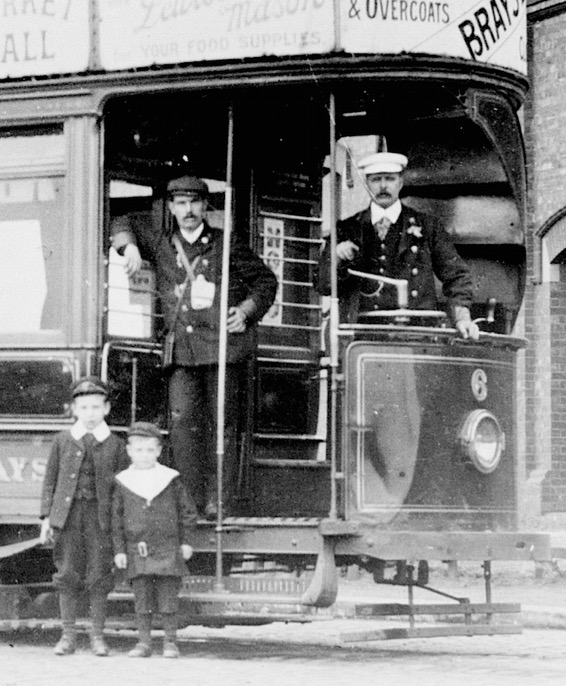
An enlargement of the above image showing the conductor and the motorman, both of whom are clearly wearing uniforms, but with flat caps, suggesting that official headwear was late in arriving.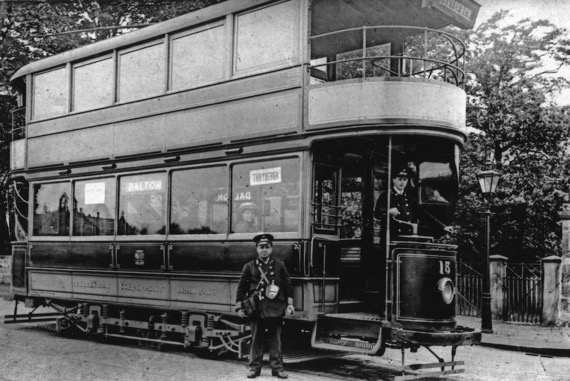
RCT Tramcar No 15 in its 1920 condition, when it re-entered service after being re-bodied by English Electric; although the photograph is undated, it was probably taken in 1920 or 1921. Author's Collection.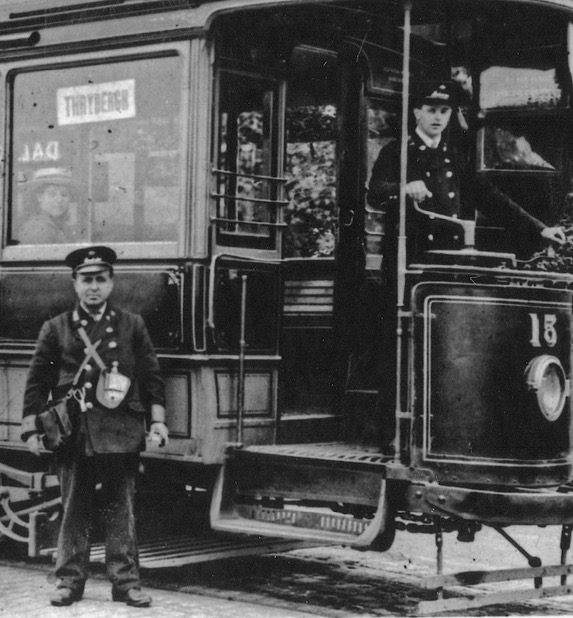
An enlargement of the above image showing the conductor and the motorman. Both men are wearing tensioned-crown peaked caps with script-lettering grade badges, above which is a Rotherham municipal-device badge. Although it is difficult to make out on this photograph, the jacket collars carry system initials on one side and an employee number on the other.
Standard off-the-shelf script-lettering grade badges of the type used by the Rotherham Corporation Tramways — brass. Although the uniform insignia were changed to nickel in the early 1920s, this very probably never applied to the grade badges, as they were dispensed with around the same time. Author's Collection.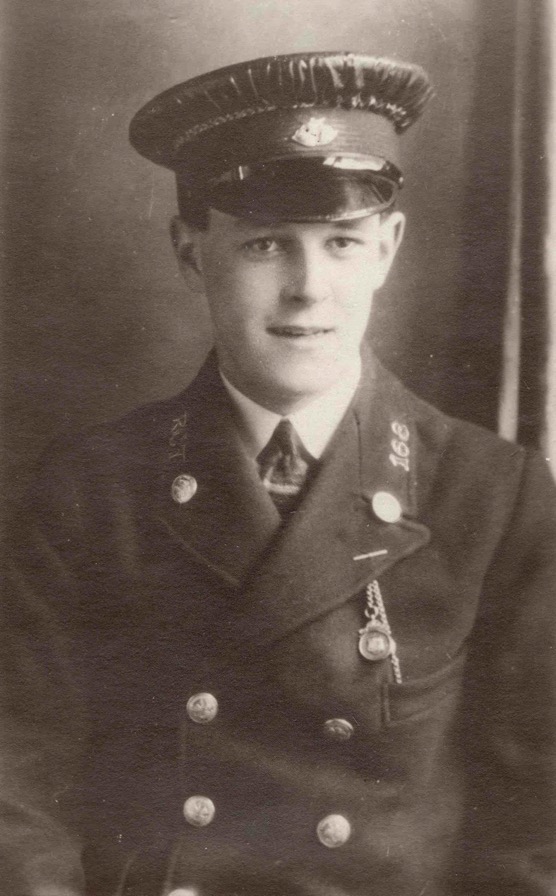
A rare studio portrait of a Rotherham Corporation Tramways employee (No 168), probably a conductor. The photo is undated, but was more than likely taken in the 1920s or 1930s. Author's Collection; with thanks to Bruce Anthony.
An enlargement of the above photograph showing details of the uniform insignia. The subject's right-hand collar bears individual 'R C T' system initials, the left an employee number (168). His cap bears the standard municipal-device badge, the script-lettering grade badges having fallen out of use in the early 1920s.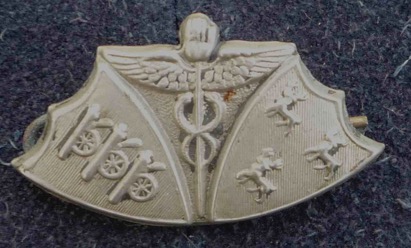
Rotherham Corporation Tramways municipal-device badge — nickel. These badges were worn on crew caps from at least the mid-Edwardian era onwards, and probably from the inception of services in 1920. They were almost certainly brass initially, a switch being made to nickel at some point, possibly shortly after the Great War. Author's Collection.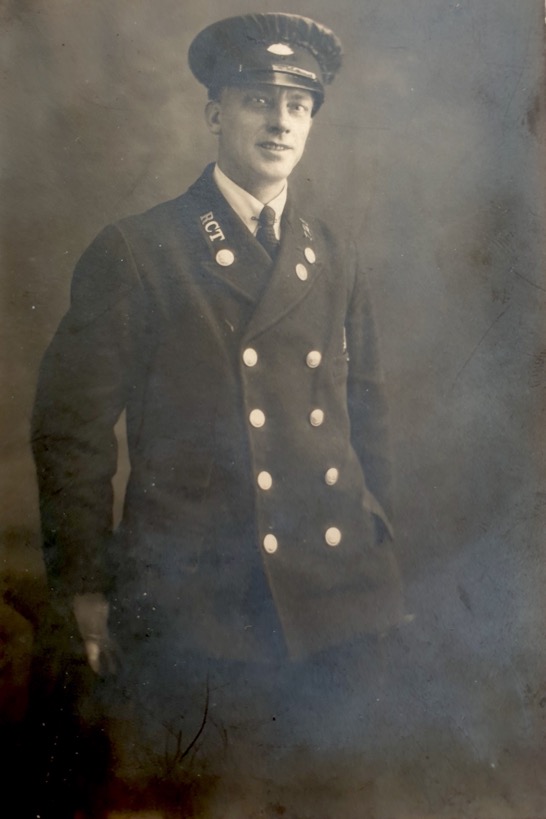
Rotherham Corporation Tramways Conductor Harry Astbury, who was born in Sheffield in 1886, and who looks to be around 40 years old in this photograph, dating it to the mid-1920s. Harry Astbury was a tram conductor when the photograph was taken, and later in his career, an inspector. Photograph courtesy of Stephen Astbury, Harry Astbury's grandson.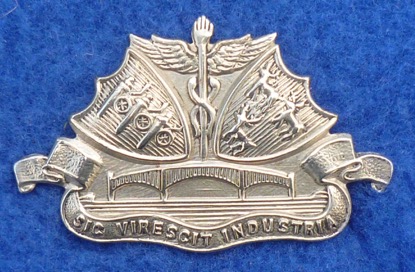
Photographs taken in the 1940s suggest that a slightly larger cap badge was worn than that used previously. It is possible, though by no means certain, that the nickel badge depicted here, with a bridge and the motto underneath, may have been the pattern worn by tramway staff during the last few years of municipal tramway operation. Author's Collection.